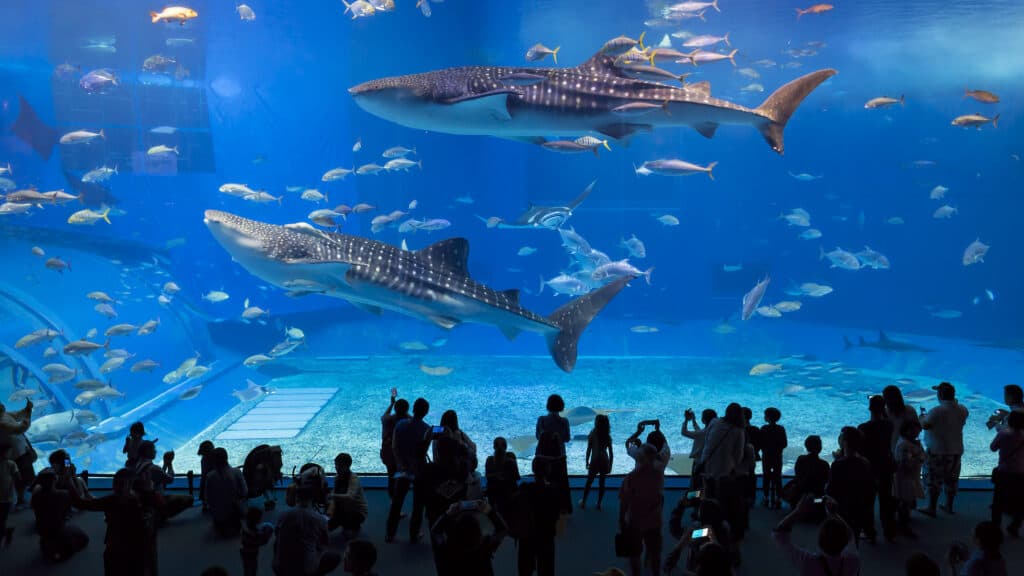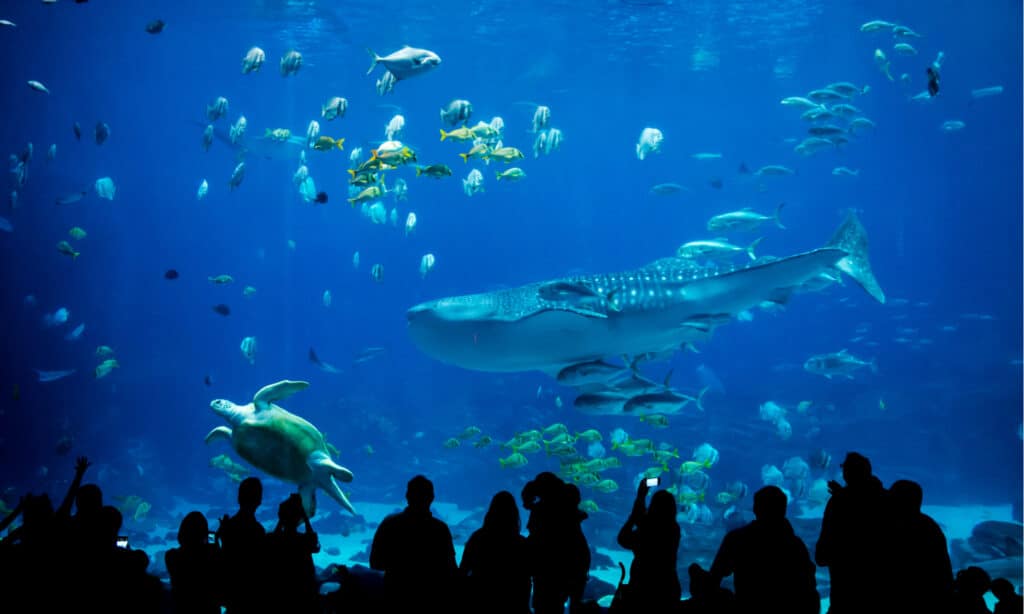The world is home to dozens of beautiful aquariums showcasing a variety of aquatic and sem-aquatic species. From whale sharks to otters to some of the rarest species of marine fish, there is no shortage of wildlife to experience at an aquarium. However, when you visit an aquarium that houses sharks with fish, you might find yourself with questions. This includes why the ocean’s apex predators don’t make a quick meal of their tank mates. Below, learn why sharks don’t eat other fish in aquariums, as well as other frequently asked questions.
Sharks in Aquariums

One way reason sharks won’t eat their tankmates is because they aren’t a part of the shark’s diet.
©Isaac Mok/Shutterstock.com
Depending on what aquarium you go to, you’ll notice that sharks can be kept with a variety of different animals. At the Georgia Aquarium in Atlanta, the whale sharks are kept in the Ocean Voyager habitat. This is a 6.3-million-gallon enclosure designed with the whale shark’s massive size in mind. As of right now, the Ocean Voyager habitat is home to a variety of animals. This includes four whale sharks, stingrays, a goliath grouper, and thousands of other fish.
With a species like the whale shark, keeping sharks from eating their tank mates is no problem. This is because, while whale sharks are predators, they don’t eat large fish. Instead, whale sharks have a diet made up of krill, crabs, jellyfish, and similar planktonic species.
But what about sharks that do regularly consume fish and other sharks?
Take a look at the North Carolina Aquarium at Fort Fisher. Here, sharks are kept in a 235,000-gallon aquarium known as the Cape Fear Shoals. This massive habitat features a sea turtle, a moray eel, stingrays, and, yes, sharks! However, unlike the whale sharks of Georgia, the sharks kept in this exhibit are sand tiger sharks. Sand tiger sharks are far smaller than whale sharks, but, they have a diet made up of fish and even other small fish. So, why don’t these sharks eat other fish in aquariums?
Why Don’t Sharks Eat Their Tank Mates?

Accidents will occur, but proper training and care can help prevent sharks from eating other fish.
©Tomas Kotouc/Shutterstock.com
You’ll be surprised to learn that the number one reason sharks don’t eat other fish in aquariums is because they’re not hungry. Along with this, they are actually trained not to eat their tank mates!
Sharks are highly intelligent animals. They are capable of complex thoughts, whether that be solving problems or recognizing familiar sharks around them. As a result, these fish respond well to training, especially positive reinforcement and target training. In psychology, this is known as operant conditioning, where positive behavior is rewarded as a way to encourage it.
When living in a diverse aquarium with other species, sharks are trained to complete task, usually approaching a target, in order to receive food. This meets their instinctual need to work for their food while also keeping their appetite satiated. As a result, there is little to no concern for even predatory sharks like Fort Fisher’s sand tiger sharks to steal a tank mate for a snack.
Have Sharks Ate Their Tank Mates Before?

The sharks at aquariums are often taught through reward-based training what is and isn’t food.
©Jakgapong Pengjank/Shutterstock.com
It is amazing that science has come far enough for professionals to understand how to keep sharks and other marine life in a location like an aquarium without sacrificing the fish’s quality of life or care. However, while we have reached a place in time where we can successfully care for animals otherwise unable to return to the wild, animals in aquariums or other zoological parks are just that: animals.
As a result, while training and keeping a shark well-fed can be highly beneficial in creating a harmonious tank environment, it isn’t perfect. Animals have instincts and a natural way of going about life, and there are times when that will show through. Sometimes a shark may not take well to eating from a human, or there may be a sick or weak fish in the aquarium. In these cases, you may find that sharks will eat their tank mates.
However, aquariums work carefully to ensure that the environment within the tank is as favorable as possible, reducing these risks. Any weak or sick fish that may draw out a shark’s hunger are removed for care, and feeding schedules are strict.
In other cases, when sharks aren’t rescues brought in from the wild, they are born in captivity. Because of this, they are raised to only eat chunks of already-dead meat. As a result, they are raised to never associate their tank mates with a quick meal.
Final Thoughts
There is no doubt about it: sharks are apex predators that dominate much of the ocean. However, by providing a healthy, regular diet and through training, accidents between captive sharks and other fish in aquariums can be greatly reduced. This is especially true for sharks born in captivity who never undergo the hunting process.
At the same time, though, it is important to recognize that sharks are wild animals with strong instincts, and even the greatest amount of training can’t completely eradicate their need to hunt when hungry.
The photo featured at the top of this post is © DannyTorobekovArt/Shutterstock.com
Thank you for reading! Have some feedback for us? Contact the AZ Animals editorial team.







